Miele G 7856, 6868521 User Manual

Operating and Installation
Instructions
Commercial Dishwasher
G 7856
To prevent accidents and machine damage read these instructions before
en - US
installation or use. |
M.-Nr. 06 868 521 |
2

Contents
IMPORTANT SAFETY INSTRUCTIONS. . . . . . . . . . . . . . . . . . . . . . . . . . . . . . . . . 4
Guide to the machine . . . . . . . . . . . . . . . . . . . . . . . . . . . . . . . . . . . . . . . . . . . . . . 8
Description of the machine . . . . . . . . . . . . . . . . . . . . . . . . . . . . . . . . . . . . . . . . . 10
Opening and closing the door . . . . . . . . . . . . . . . . . . . . . . . . . . . . . . . . . . . . . . 11
Water softener . . . . . . . . . . . . . . . . . . . . . . . . . . . . . . . . . . . . . . . . . . . . . . . . . . . 12
Setting the water softener . . . . . . . . . . . . . . . . . . . . . . . . . . . . . . . . . . . . . . . . . . . 12 Filling the salt reservoir . . . . . . . . . . . . . . . . . . . . . . . . . . . . . . . . . . . . . . . . . . . . . 14 Salt indicator . . . . . . . . . . . . . . . . . . . . . . . . . . . . . . . . . . . . . . . . . . . . . . . . . . . . . 15
Rinse aid . . . . . . . . . . . . . . . . . . . . . . . . . . . . . . . . . . . . . . . . . . . . . . . . . . . . . . . . 16
Adding rinse aid . . . . . . . . . . . . . . . . . . . . . . . . . . . . . . . . . . . . . . . . . . . . . . . . . . 16
Setting the dosage . . . . . . . . . . . . . . . . . . . . . . . . . . . . . . . . . . . . . . . . . . . . . . . . . 17
Loading the machine . . . . . . . . . . . . . . . . . . . . . . . . . . . . . . . . . . . . . . . . . . . . . . 18
Items not suitable for dishwashers . . . . . . . . . . . . . . . . . . . . . . . . . . . . . . . . . . . . 19 Adjusting the upper basket . . . . . . . . . . . . . . . . . . . . . . . . . . . . . . . . . . . . . . . . . . 21
Adding cleaning agent . . . . . . . . . . . . . . . . . . . . . . . . . . . . . . . . . . . . . . . . . . . . 22
Use . . . . . . . . . . . . . . . . . . . . . . . . . . . . . . . . . . . . . . . . . . . . . . . . . . . . . . . . . . . . 24
Turning on . . . . . . . . . . . . . . . . . . . . . . . . . . . . . . . . . . . . . . . . . . . . . . . . . . . . . . . 24 Starting a program . . . . . . . . . . . . . . . . . . . . . . . . . . . . . . . . . . . . . . . . . . . . . . . . . 24 Selecting an additional function . . . . . . . . . . . . . . . . . . . . . . . . . . . . . . . . . . . . . . 25 Program sequence display . . . . . . . . . . . . . . . . . . . . . . . . . . . . . . . . . . . . . . . . . . 25 At the end of a program. . . . . . . . . . . . . . . . . . . . . . . . . . . . . . . . . . . . . . . . . . . . . 25 Turning off . . . . . . . . . . . . . . . . . . . . . . . . . . . . . . . . . . . . . . . . . . . . . . . . . . . . . . . 25 Changing a program . . . . . . . . . . . . . . . . . . . . . . . . . . . . . . . . . . . . . . . . . . . . . . . 26 Canceling a program . . . . . . . . . . . . . . . . . . . . . . . . . . . . . . . . . . . . . . . . . . . . . . . 26
Program guide . . . . . . . . . . . . . . . . . . . . . . . . . . . . . . . . . . . . . . . . . . . . . . . . . . . 27
Programming special functions . . . . . . . . . . . . . . . . . . . . . . . . . . . . . . . . . . . . . 29
Machine care . . . . . . . . . . . . . . . . . . . . . . . . . . . . . . . . . . . . . . . . . . . . . . . . . . . . 37
Correcting minor faults . . . . . . . . . . . . . . . . . . . . . . . . . . . . . . . . . . . . . . . . . . . . 41
After Sales Service . . . . . . . . . . . . . . . . . . . . . . . . . . . . . . . . . . . . . . . . . . . . . . . 43
INSTALLATION INSTRUCTIONS. . . . . . . . . . . . . . . . . . . . . . . . . . . . . . . . . . . . . 45
Caring for the environment . . . . . . . . . . . . . . . . . . . . . . . . . . . . . . . . . . . . . . . . . 46
Installation . . . . . . . . . . . . . . . . . . . . . . . . . . . . . . . . . . . . . . . . . . . . . . . . . . . . . . 47
Electrical connection. . . . . . . . . . . . . . . . . . . . . . . . . . . . . . . . . . . . . . . . . . . . . . 49
Plumbing. . . . . . . . . . . . . . . . . . . . . . . . . . . . . . . . . . . . . . . . . . . . . . . . . . . . . . . . 51
Technical data . . . . . . . . . . . . . . . . . . . . . . . . . . . . . . . . . . . . . . . . . . . . . . . . . . . 53
3
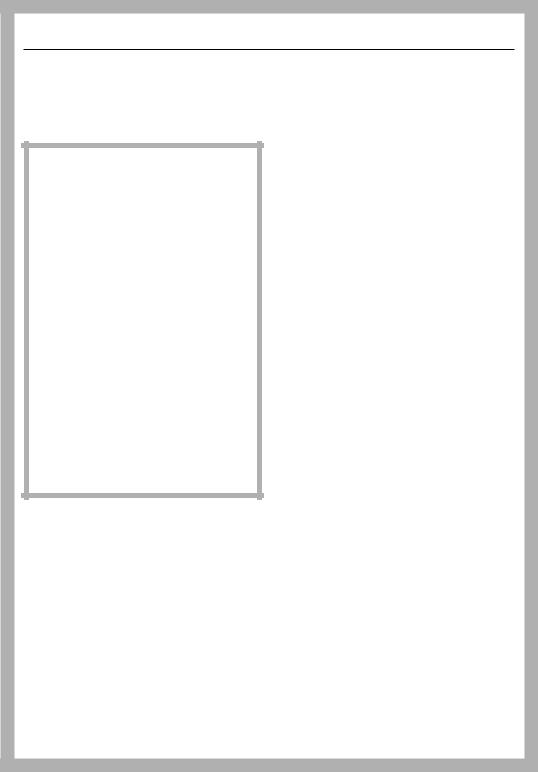
IMPORTANT SAFETY INSTRUCTIONS
WARNING -
When using your dishwasher follow basic precautions, including the following:
This dishwasher is only intended for specialized applications. Only use the machine for its intended purpose. Any other use, conversion or modification is dangerous. The manufacturer cannot be held responsible for damages caused by improper use of this machine.
This dishwasher complies with current safety requirements. Improper use of the machine can lead to personal injury and material damage.
Read all instructions before installing or using this machine.
Keep these operating instructions in a safe place and pass them on to any future user.
Installation and service
~Installation and repair work should be performed by a Miele authorized service technician. Work by unqualified persons could be dangerous and may void the warranty.
~Do not use the machine until properly installed.
~Do not install the machine in an area where a danger of explosion or of freezing temperatures may be present.
~The installation of this unit in non-stationary locations (e.g. ships) must be performed by a qualified installer or service agency, in strict accordance with national and local safety regulations and standards.
~Before installation, make sure that the voltage and frequency listed on the data plate correspond with the household electrical supply. This data must correspond to prevent injury and machine damage. Consult a qualified electrician if in doubt.
~Be certain this machine is properly installed and grounded by an authorized technician. To guarantee the electrical safety of this machine, continuity must exist between the machine and an effective grounding system. It is imperative that this basic safety requirement be met. If there is any doubt, have the electrical system checked by a qualified technician. The manufacturer cannot be held responsible for damage or injury, such as electric shock, caused by missing or defective grounding.
~Do not install or use a damaged dishwasher. A damaged machine is dangerous. Unplug the machine and call your Miele dealer or the Miele Technical Service Department.
4

IMPORTANT SAFETY INSTRUCTIONS
~If the power cord is damaged it must only be replaced by a Miele Service technician with a genuine Miele power cord.
~Do not use an extension cord to connect this machine to electricity. Extension cords do not guarantee the required safety of the machine (e.g. danger of overheating).
~Defective components should be replaced by Miele original parts only. Only with these parts does the manufacturer guarantee that they comply with safety requirements.
~Before installation or service, disconnect the power supply to the work area by unplugging the unit, "tripping" the circuit breaker or removing the fuse.
~When work has been performed on the supply plumbing, the supply line to the commercial dishwasher must be bled.
Otherwise, the water softening system may be damaged.
Use
~Please follow the advice on installation in this manual and in the separate Installation Instructions.
~Personnel operating the machine should be trained regularly.
~Persons who lack physical, sensory or mental abilities, or experience with the machine should not use it without supervision or instruction by a responsible person.
~Do not allow children to play in or around the dishwasher, or to operate it.
~Do not tamper with the controls.
~BURN AND SCALD HAZARD
This dishwasher reaches very high temperatures. Take care when unloading the unit. Let baskets and inserts cool before touching them. Any water which may remain in containers will be very hot and should be emptied into the wash cabinet.
~BURN HAZARD
The heating elements become extremely hot during use. Do not touch the heating elements during or directly after the end of a program.
~Take care when handling liquids such as detergent, rinsing, wetting, or neutralizing agents. These may contain irritant or caustic ingredients. Do not use any organic solvents. Danger of explosion!
Follow the instructions and relevant safety procedures carefully. Wear protective gloves and goggles. The manufacturer’s safety conditions must be observed with all chemical agents.
5

IMPORTANT SAFETY INSTRUCTIONS
~Under certain conditions, hydrogen gas may be produced in a hot water system that has not been used for two weeks or more. HYDROGEN GAS IS EXPLOSIVE. If the hot water system has not been used for such a period, turn on all hot water faucets and let water flow from each for several minutes before using the dishwasher. This will release any accumulated hydrogen gas. Do not smoke or use an open flame during this time.
~Avoid inhaling detergent. If swallowed, it can cause burning in the mouth and throat or inhibit breathing.
~Be careful when sorting and loading items to be washed: locate sharp items so that they are not likely to damage the door seal; and load sharp knives with the handles up to reduce the risk of injuries.
~The water in the machine must not be used as drinking water.
~Do not sit or lean on the open door. This could cause the machine to tip or be damaged.
~Never clean the machine or near its vicinity with a water or high pressure hose.
~Only use cleaning agents formulated for special processes and approved by Miele for use with this machine. Keep all cleaning agents out of the reach of children. Use of unsuitable cleaning agents could adversely affect the
components of the machine.
~Use only rinse agents for commercial dishwashers. When other rinse agents are used, there is the danger that the rinse load and the dishwasher might be damaged.
~Pre-treatments with detergents can create suds, as can certain rinsing agents. For pre-treatment and / or cleaning only, use low-sudsing detergents which have been approved by Miele. Suds can have an adverse effect on the cleaning process.
~When a chemical additive is recommended on technical application grounds (e.g. with a detergent), this does not imply that the manufacturer of the dishwasher takes responsibility for the affect of the chemical on the material of the items being cleaned. Please be aware that changes in formulation, storage conditions, etc., which may not be publicized by the chemical producer, can have a negative effect on the cleaning result.
~Always follow the instructions of the chemical manufacturer when using detergents and special application chemicals. Only use such chemicals for the purpose and in the situation specified to avoid such dangers as chemical reactions and material damage.
~The dishwasher is designed only for operation with water and additive cleaning agents. Organic solvents must not be used in the machine. An explosion or machine corrosion could occur with the use of organic solvents.
6

IMPORTANT SAFETY INSTRUCTIONS
~In critical applications where very stringent requirements must be met, it is highly recommended that all relevant factors for the process, such as cleaning agent, quality of water, etc., be discussed with a Miele Application Specialist.
~The special inserts should only be used for their specific application.
~Do not wash plastic items unless they are marked "dishwasher safe" or the equivalent. If in doubt follow the manufacturers recommendations.
~Empty any containers or utensils before arranging them in the machine.
~Do not allow any remains of acids or solvents, particularly hydrochloric acid or chloride solutions, to get into the wash cabinet. The presence of any solvents should be minimized (especially those in hazard class A1).
~To avoid corrosion damage ensure that solutions or steam containing hydrochloric acid do not come into contact with the steel outer casing of the machine.
Disposal of the old machine
~When disposing of your old dishwasher first make it unusable. Disconnect it from the mains power supply, cut off the cable and plug from the cable.
~For environmental and safety reasons ensure the machine is completely drained of any residual water and detergent. (Observe safety regulations and wear safety goggles and gloves).
~Remove the door to the washing compartment, so that children cannot accidentally shut themselves in. Make appropriate arrangements for the safe and environmentally responsible disposal of the machine.
~For tank system machines ensure that all water is emptied out the tank.
The manufacturer cannot be held responsible for any damage caused by non-observance of these Important Safety Instructions.
Accessories
~Only specific additional equipment, made by Miele or approved by Miele, should be connected to this machine. Consult Miele on the type and application of such equipment.
SAVE THESE INSTRUCTIONS
7
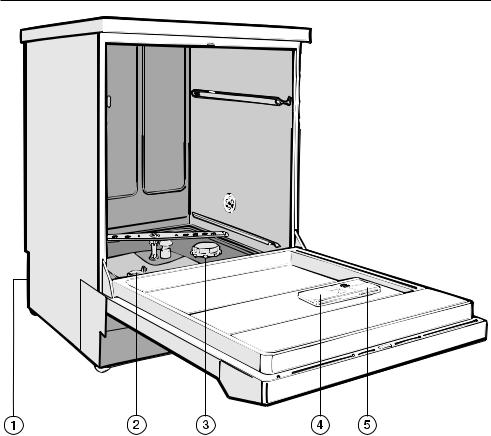
Guide to the machine
a Connection for DOS unit G 60 Dosage pump for liquid detergents - optional
(located on the rear side of the machine)
b Filter combination
c Salt reservoir (water softener)
d Compartment for powder detergent
e Rinse aid reservoir (with dosage selector)
8

Guide to the machine
a On/Off button (I-0)
b Door button
c Display
d Delay Start indicator
(see "Programming special functions")
e Extra drying indicator
f Start indicator
g Start button
h Extra drying button
i Display button to toggle between "Actual time" and "Elapsed wash time"
j Serial interface
(for use by Service Technicians)
k Add liquid cleaning agent indicator (only applies to machines equipped with an optional external DOS module)
l Add rinse aid indicator
m Add salt indicator
n Check water inlet/drain indicator
o Program sequence indicator
p Program selector
9

Description of the machine
This Miele machine is a commercial dishwasher with fresh water wash system and short batch times. It is especially suitable for use where quick turn-around flexible wash programs, and commercial durability are of the utmost importance.
The dishwasher is equipped with a water softener as a standard.
10

Opening and closing the door
To open the door
^Press the door button, hold the door grip and pull open the door at the same time.
The door should only be opened during operation for emergencies, e.g. if items are knocking together or if a program fault is indicated in the display. See "Canceling a program".
,Do not touch the heating elements during or directly after the end of a program, you could burn yourself. They remain hot for some time after the end of the program.
When using the "Rapid" program the door must be kept closed between loads. The condensed water which builds up in the machine could cause corrosion or damage to surrounding countertops or furniture. See advice on installation locations in the "Installation" section of this manual.
To close the door
^Lift the door upwards and push until it clicks shut. Do not press the door button while shutting the door.
11

Water softener
Water Softener
To avoid the build-up of calcium deposits on items being cleaned and in the machine the water needs to be softened.
To ensure a steady supply of soft water the water softener unit must always be:
1.correctly set for the water hardness level in your area.
2.the salt reservoir must be filled.
(If the water hardness level is below 4 gr/gal (4 °d - German scale) the water does not need to be softened.)
The machine is set at the factory for a water hardness level of 19 gr/gal (19°d).
If the water supply is harder or softer than this (including below 4 gr/gal or 4 °d) the factory setting will need to be changed. For settings see chart.
Your local water authority will advise you of the water hardness in your area.
For fluctuating levels (e.g. 8 - 17 gr/gal or 8 - 17 °d) set the water softener to the highest setting (in this example to 17 gr/gal or 17°d).
The built-in water softener has settings from 1 - 62 gr/gal or 1 °d - 60 °d.
^ Enter your water hardness level here:
°d / gr/gal
Setting the water softener
^Turn the machine off.
^Turn the program selector to "STOP".
^Press and hold the "Display" and "Start" buttons, and turn on the machine with the "On / Off" button. The actual program status "P..." is displayed.
The "Fill/Drain" indicator lights.
^Press the "Extra Drying" button once. "E01" (program level 1) appears in the display.
^Turn the program selector to the 6 o’clock position.
The number "19" is displayed (the factory water hardness setting in °d, equivalent to 19 gr/gal).
^Press and hold the "Display" button until the required value (water hardness in °d) is displayed.
The counter returns to "0" after reaching "60".
^Press the "Start" button. "SP" appears.
^Press the "Start" button once more. The setting will now be stored. The display clears.
The machine is now ready for operation.
12

Water softener
Table of settings
°d |
|
|
(German |
gr/gal |
Setting |
scale) |
|
|
|
|
|
1 |
1 |
1 |
2 |
2 |
2 |
3 |
3 |
3 |
4 |
4 |
4 |
5 |
5 |
5 |
6 |
6 |
6 |
7 |
7 |
7 |
8 |
8 |
8 |
9 |
9 |
9 |
10 |
10 |
10 |
11 |
11 |
11 |
12 |
12 |
12 |
13 |
13 |
13 |
14 |
14 |
14 |
15 |
15 |
15 |
16 |
16 |
16 |
17 |
17 |
17 |
18 |
18 |
18 |
19 *) |
19 |
19 |
20 |
20 |
20 |
21 |
21 |
21 |
22 |
22 |
22 |
23 |
23 |
23 |
24 |
25 |
24 |
25 |
26 |
25 |
26 |
27 |
26 |
27 |
28 |
27 |
28 |
29 |
28 |
29 |
30 |
29 |
30 |
31 |
30 |
31 |
32 |
31 |
32 |
33 |
32 |
33 |
34 |
33 |
34 |
35 |
34 |
35 |
36 |
35 |
36 |
37 |
36 |
37 |
38 |
37 |
38 |
39 |
38 |
39 |
40 |
39 |
40 |
41 |
40 |
41 |
42 |
41 |
42 |
43 |
42 |
43 |
44 |
43 |
44 |
45 |
44 |
45 |
46 |
45 |
|
|
|
°d |
|
|
(German |
gr/gal |
Setting |
scale) |
|
|
|
|
|
46 |
47 |
46 |
47 |
49 |
47 |
48 |
50 |
48 |
49 |
51 |
49 |
50 |
52 |
50 |
51 |
53 |
51 |
52 |
54 |
52 |
53 |
55 |
53 |
54 |
56 |
54 |
55 |
57 |
55 |
56 |
58 |
56 |
57 |
59 |
57 |
58 |
60 |
58 |
59 |
61 |
59 |
60 |
62 |
60 |
|
|
|
*) factory setting
13
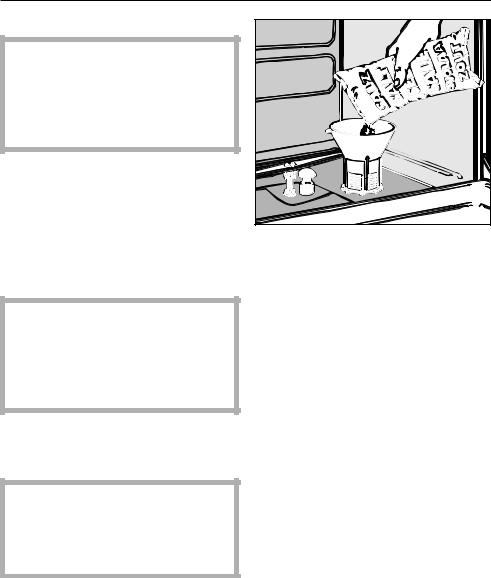
Water softener
Filling the salt reservoir
Only special, coarse-grained reactivation salt* should be used in this machine.
*Available from Miele. Please see back page for contact information.
Do not use other types of salt, e.g. table salt, agricultural or gritting salt. These could contain components which are insoluble in water and could damage the water softener. If in doubt, consult Miele’s Professional Department.
The salt reservoir holds approximately 5.5 lbs (2.5 kg) of salt.
,Inadvertently filling the salt reservoir with detergent will damage the water softener.
Before filling, make sure you are using reactivation salt.
^Remove the bottom basket from the machine.
^Unscrew the salt reservoir cap.
Important: The salt container must be filled with 0.6 gal (2.5 l) of water before adding salt for the first time. Water does not have to be added with subsequent refills.
^ Place the funnel (provided) in place.
^Carefully fill the reservoir with salt. Displaced water will run out as it is being filled.
^Wipe any residual salt off the screw threads.
^Screw the cap on firmly.
^Immediately after this step: Run the "Rinse" program to remove any traces of salt from the cabinet.
Note: There may be a delay before the "Rinse" program starts due to the reactivation of the water softener.
14
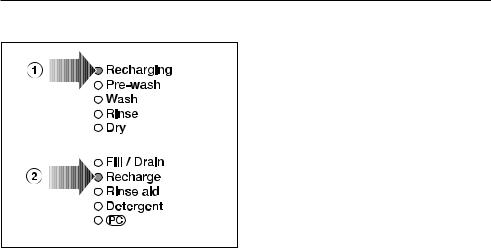
Water softener
Salt indicator
When the salt reservoir is empty the "Recharge" indicator, b, lights as a reminder to fill the reservoir.
Reactivation takes place automatically during a program. The "Recharging" indicator, a, lights while this is occurring.
15
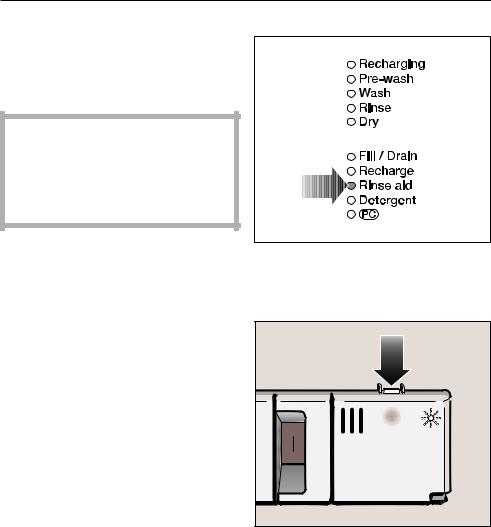
Rinse aid
Rinse aid is needed to prevent spotting on dishes and glassware.
The rinse aid is filled in the reservoir and the set amount will be automatically dispensed during the final rinse. The reservoir holds about 125 ml.
,Inadvertently filling the rinse aid reservoir with detergent (liquid or powder detergent) will damage the reservoir!
Only use rinse aid approved for this dishwasher.
Adding rinse aid
If the "Rinse aid" indicator lights, the rinse aid reservoir must be refilled.
^ Open the door fully. |
^Press the button in the direction of the arrow until the flap springs open.
16

Rinse aid
Setting the dosage
^Add rinse aid until it is visible on the surface of the filter in the opening.
^Close the flap until it clicks into place. Make sure it is firmly shut, otherwise water could get into the rinse aid reservoir during the program.
^Clean up any spilled rinse aid to prevent over-foaming during the next program.
The flap should always remain closed. Only open it to add more rinse aid.
^Only add rinse aid when the rinse aid indicator comes on.
The dosage selector (see arrow) is preset to 3. This dispenses approximately 3 ml of rinse aid per program. It can be adjusted from 1 to 6.
^Use a higher setting if spots appear on dry glassware.
^Use a lower setting if streaking appears on dishes or glasses.
17
